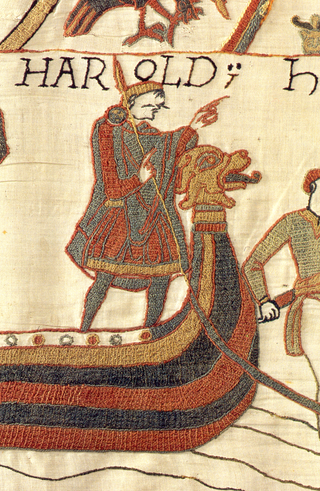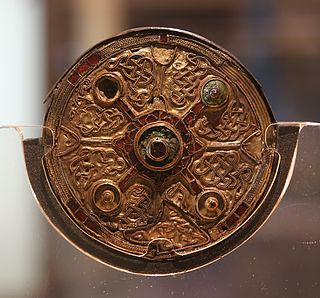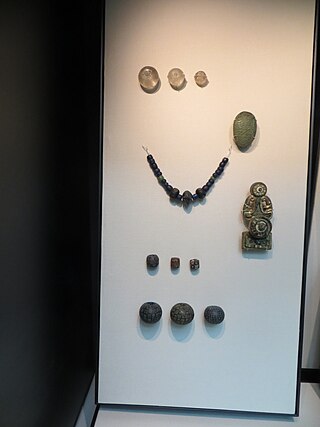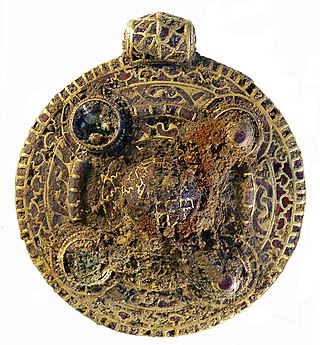
Sutton Hoo is the site of two early medieval cemeteries dating from the 6th to 7th centuries near the English town of Woodbridge. Archaeologists have been excavating the area since 1938, when a previously undisturbed ship burial containing a wealth of Anglo-Saxon artefacts was discovered. The site is important in establishing the history of the Anglo-Saxon kingdom of East Anglia as well as illuminating the Anglo-Saxons during a period which lacks historical documentation.

The Håga mound (Hågahögen) or King Björn's Mound is a large Nordic Bronze Age tumulus in the western outskirts of Uppsala, Sweden. It is one of the most magnificent remains from the Nordic Bronze Age. It is Scandinavia's most gold-rich bronze age grave ever found.

The Grave Creek Mound in the Ohio River Valley in West Virginia is one of the largest conical-type burial mounds in the United States, now standing 62 feet (19 m) high and 240 feet (73 m) in diameter. The builders of the site, members of the Adena culture, moved more than 60,000 tons of dirt to create it about 250–150 BC.
Kingston is a village and civil parish between Canterbury and Dover in Kent, South East England. The parish contains the hamlet of Marley.

Anglo-Saxon dress refers to the clothing and accessories worn by the Anglo-Saxons from the middle of the fifth century to the eleventh century. Archaeological finds in Anglo-Saxon cemeteries have provided the best source of information on Anglo-Saxon costume. It is possible to reconstruct Anglo-Saxon dress using archaeological evidence combined with Anglo-Saxon and European art, writing and literature of the period. Archaeological finds have both supported and contradicted the characteristic Anglo-Saxon costume as illustrated and described by these contemporary sources.

The Sutton Hoo purse-lid is one of the major objects excavated from the Anglo-Saxon royal burial-ground at Sutton Hoo in Suffolk, England. The site contains a collection of burial mounds, of which much the most significant is the undisturbed ship burial in Mound 1 containing very rich grave goods including the purse-lid. The person buried in Mound 1 is usually thought to have been Rædwald, King of East Anglia, who died around 624. The purse-lid is considered to be "one of the most remarkable creations of the early medieval period." About seven and a half inches long, it is decorated with beautiful ornament in gold and garnet cloisonné enamel, and was undoubtedly a symbol of great wealth and status. In 2017 the purse-lid was on display at the British Museum.

The Taplow Barrow is an early medieval burial mound in Taplow Court, an estate in the south-eastern English county of Buckinghamshire. Constructed in the seventh century, when the region was part of an Anglo-Saxon kingdom, it contained the remains of a deceased individual and their grave goods, now mostly in the British Museum. It is often referred to in archaeology as the Taplow burial.
Burial in Anglo-Saxon England refers to the grave and burial customs followed by the Anglo-Saxons between the mid 5th and 11th centuries CE in Early Mediaeval England. The variation of the practice performed by the Anglo-Saxon peoples during this period, included the use of both cremation and inhumation. There is a commonality in the burial places between the rich and poor – their resting places sit alongside one another in shared cemeteries. Both of these forms of burial were typically accompanied by grave goods, which included food, jewelry, and weaponry. The actual burials themselves, whether of cremated or inhumed remains, were placed in a variety of sites, including in cemeteries, burial mounds or, more rarely, in ship burials.

Bryan Faussett was an English antiquary. Faussett formed a collection that was rich in Anglo-Saxon objects of personal adornment, such as pendants, brooches, beads and buckles. He discovered the Kingston Brooch, the largest known Anglo-Saxon composite brooch. At the time of his death he had the world's largest collection of Anglo-Saxon items.

The Castalian Springs Mound State Historic Site (40SU14) is a Mississippian culture archaeological site located near the small unincorporated community of Castalian Springs in Sumner County, Tennessee. The site was first excavated in the 1890s and again as recently as the 2005 to 2011 archaeological field school led by Dr. Kevin E. Smith. A number of important finds have been associated with the site, most particularly several examples of Mississippian stone statuary and the Castalian Springs shell gorget held by the National Museum of the American Indian. The site is owned by the State of Tennessee and is a State Historic Site managed by the Bledsoe's Lick Association for the Tennessee Historical Commission. The site is not currently open to the public.

Joseph Mayer (1803–1886) was an English goldsmith, antiquary and collector.

The Street House Anglo-Saxon cemetery is an Anglo-Saxon burial ground, dating to the second half of the 7th century AD, that was discovered at Street House Farm near Loftus, in the unitary authority of Redcar and Cleveland, England. Monuments dating back as far as 3300 BC are located in the vicinity of the cemetery, which was discovered after aerial photography revealed the existence of an Iron Age rectangular enclosure. The excavations, carried out between 2005 and 2007, revealed over a hundred graves dating from the 7th century AD and the remains of several buildings. An array of jewellery and other artefacts was found, including the jewels once worn by a young high-status Anglo-Saxon woman who had been buried on a bed and covered by an earth mound.

The Tangendorf disc brooch is an Iron Age fibula from the 3rd century AD, which was dug up in 1930 from the sand of a Bronze Age tumulus near Tangendorf, Toppenstedt, Harburg, Lower Saxony, Germany. The front of the elaborately crafted garment fibula is decorated with a rear-facing four-legged animal, probably a dog or a deer. It is one of Harburg's most important finds from the period of the Roman Empire, and is in the permanent exhibition of the Archaeological Museum Hamburg in Harburg, Hamburg.

The Harford Farm Brooch is a 7th-century Anglo-Saxon disk brooch. The brooch was originally made in Kent and was found along with a number of other artifacts during an excavation of an Anglo-Saxon cemetery at Harford Farm in Norfolk. The brooch measures 72 millimetres (2.8 in) across and was found in grave 11. The front of the brooch is gold decorated with glass and garnets while the backplate is silver. On the back of the brooch there is a runic inscription reading "ᛚᚢᛞᚪ:ᚷᛁᛒᛟᛏᚫᛋᛁᚷᛁᛚᚫ" (luda:gibœtæsigilæ), which Norfolk Museums & Archaeology Service translates as “Luda repaired the brooch”; however “may Luda make amends by means of the brooch” has been offered as a translation by Alfred Bammesberger in the journal Neophilologus. In addition to the runes, the back of the brooch also has a scratched zoomorphic decoration.

The Sutri Treasure is an important Lombardic hoard found at Sutri, Italy in the late nineteenth century that is currently in the collections of the British Museum in London.

The Artres Treasure is an important Merovingian hoard found at Artres, northern France in the nineteenth century. Most of the treasure is now in the collection of the British Museum in London.

The Tromsø Burial or Tromsø Grave Group is a significant hoard of Viking objects found near Tromsø, in the far north of Norway, in the late nineteenth century. Since 1900, the group has been part of the British Museum's early medieval collection.

A disc fibula or disc brooch is a type of fibula, that is, a brooch, clip or pin used to fasten clothing that has a disc-shaped, often richly decorated plate or disc covering the fastener. The terms are mostly used in relation to the Middle Ages of Europe, especially the earlier part of the period. They were the most common style of Anglo-Saxon brooches.

Anglo-Saxon brooches are a large group of decorative brooches found in England from the fifth to the eleventh centuries. In the early Anglo-Saxon era, there were two main categories of brooch: the long (bow) brooch and the circular (disc) brooch. The long brooch category includes cruciform, square-headed, radiate-headed, and small-long brooch brooches. The long brooches went out of fashion by the end of the sixth century.

The Winfarthing pendant is a seventh century Anglo-Saxon disc brooch that was found in an undisturbed grave in 2014 near Diss, Norfolk. The gold composite pendant is inlaid with hundreds of small garnets. The pendant is currently on display at the Norfolk Castle Museum.


















